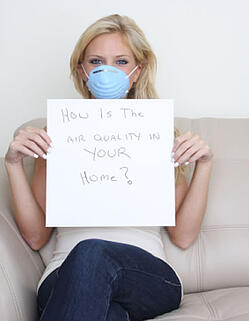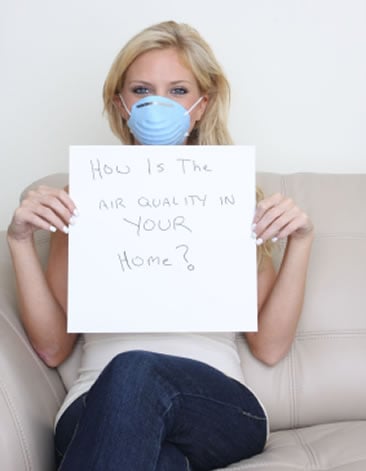 There is a saying, "When you own your breath, nobody can steal your peace" (author unknown). As a holistic health promoter, you know that breathing is vital to optimum wellness and the health benefits of oxygen to the body. You have probably taken at least one yoga or meditation class and have practiced abdominal breathing. But have you ever had the experience where you wake up wheezing with swollen puffy eyes, stuffy nose, a sinus headache, or a lingering cough that is worse upon waking up? If so, you may have a problem with the air quality in your home.
There is a saying, "When you own your breath, nobody can steal your peace" (author unknown). As a holistic health promoter, you know that breathing is vital to optimum wellness and the health benefits of oxygen to the body. You have probably taken at least one yoga or meditation class and have practiced abdominal breathing. But have you ever had the experience where you wake up wheezing with swollen puffy eyes, stuffy nose, a sinus headache, or a lingering cough that is worse upon waking up? If so, you may have a problem with the air quality in your home.
Many factors can contribute to poor air quality anywhere in the country that can make you miserable, especially in the damp and cold of fall and winter months when homes are not as opened up to fresh air. What you're experiencing may be caused by indoor air pollution.
Toxic substances in the home can compromise Indoor Air Quality (IAQ). Tobacco smoke, chemical cleaning products containing Volatile Organic Compounds (VOCs), dust mites, pet dander, mold and mildew are the leading offenders.
We at the American College of Healthcare Sciences are located in the beautiful Pacific Northwest, famous for its moderate wet weather and socially responsible citizens. It may surprise you to know that even in this Eden for holistic living, respiratory problems are everywhere. Though the rate of asthma is slightly lower than national average, we do live in a rain forest climate. Our moist environment is particularly prone to mold and mildew growth and associated coughs and sniffles.
As the cold, wet weather approaches, here are 10 tips to help you avoid exposure to indoor air pollution:
1. Improve Ventilation
Change or clean the air filters on your heating and air conditioning systems. Be sure there is no indoor smoke exposure. Have the ductwork cleaned by a service company periodically—or if you notice air quality problems. Maximize fresh air ventilation.
2. Install a Carbon Monoxide Detector
Detectors are inexpensive ($15-60) and can prevent toxic exposure that could lead to a fatality in your home.
3. Test for Radon
Test your home for radon with a do-it-yourself radon kit. Radon is a naturally occurring gas that can seep from the ground into your home causing increased risk of lung cancer.
4. Wash Your Hair Before Bed
Human hair is like a magnet for attracting pollen and dust and other nasty things best left outside. When you sleep, you breathe in all of the bits and pieces your hair has accumulated during the day.
5. Change Your Pillowcases Frequently
All this debris from your hair can build up on your pillow case, aggravating respiratory inflammation. Washing your hair and sleeping on a clean pillowcase can make a big difference.
6. Buy Products That Contain Low VOCs or No VOCs
Many Volatile Organic Compounds (VOCs) are harmful toxins (respiratory and neurological impact) that can be released (off-gassed) by cleaning products, insecticides, paints, new carpets, furniture, and other household items. (See the aromatherapy Air Freshener recipe later in this post for a VOC-free organic air freshener!)
7. Hepa Filter Vacuums
Vacuum carpets and soft furniture frequently with (HEPA High Efficiency Particulate Air) filter systems that can trap tiny particles such as pollen and dust mites, which can trigger allergies and other respiratory issues.
8. Reduce Exposure to Pet Dander
Dander is a combination of dead skin cells and hair or feathers, which can trigger asthma and allergic reactions. Reduce exposure by keeping pets out of the bedroom and on non-carpeted floors. Certain breeds of dogs (i.e., poodles) have less dander. More people seem to react to cat dander.
9. Keep Humidity Below 50% to Avoid Mold and Mildew
Use exhaust fans in bathrooms and kitchens, and vent clothes dryers to outside. Repair leaks immediately and prevent moisture that promotes growth of mold and mildew. Be sure there is no standing water in air conditioners. Get professional help for severe or recurring cases of mold or mildew.
10. Support Healthy Immune Function
Use holistic remedies that support a healthy immune system and comfort minor irritation. Try these holistic recipes (below) from the collection of organic supplies at the ACHS Apothecary Shoppe College Store.
Fennel Honey Respiratory Support
Fennel Foeniculum vulgare essential oil: 1-3 drops
Honey: 1 tablespoon
Mix the two together and take 1 teaspoon as frequently as required.
Air Freshener
Lavender Lavandula angustifolia essential oil: 15 drops
Orange Citrus sinensis essential oil: 10 drops
Lemon Citrus limonum essential oil: 10 drops
Grapefruit Citrus paradisi essential oil: 10 drops
Lime Citrus aurantifolia essential oil: 6 drops
Nutmeg Myristica fragrans essential oil: 3 drops
Distilled water: 2 ounces
Alcohol, vodka, or grain: 2 ounces
Blend all the ingredients and put in a spray bottle. Shake well. And—breathe easy this fall!
ACHS is always looking for new ways to empower our holistic health community! If you have questions, comments, or holistic recipes to share, please leave a comment. We'd love to continue the conversation. And please feel free to share these great tips with a friend—just click the Like button at the top.
References
ACHS. (2013). Lemon Aromatherapy Essential Oil. Retrieved from Apothecary Shoppe: http://www.apothecary-shoppe.com/
EPA. (2013). Guide to Air Cleaners in the Home. Retrieved from Environmental Protection Agency: http://www.epa.gov/iaq/pubs/airclean.html
EPA. (2013). Volatile Organic Compounds. Retrieved from Environmental Protection Agency: http://www.epa.gov/iaq/pubs/hpguide.html#VOCs
NCCAM. (2013). Seasonal Allergies. Retrieved from National Center for Comlementary and Alternative Medicine: http://nccam.nih.gov/health/allergies
CDC. (2013) Asthma. Retrieved from Centers for Disease Control and Prevention: http://www.cdc.gov/asthma/asthmadata.htm
This article is for informational purposes only. It is not intended to treat, diagnose, cure, or prevent disease. This article has not been reviewed by the FDA. Always consult with your primary care physician or naturopathic doctor before making any significant changes to your health and wellness routine.






